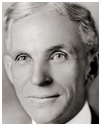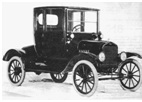|
 |
|
 |
|
|
||
Production
Production is...
Making goods like cars (called manufacturing), or....
Providing services like banking or store retailing (called operations).
So the management of production is often called operations management.
How are goods manufactured?
1. Mass production
Mass production was first used by Henry Ford (pictured right) to make the Model T car (pictured right below).
2. Batch production A small number of products are made. Used by smaller companies who make top quality, handmade goods
3. Job production Something is individually made to customer specifications.
How to have perfect production
1. Put customers first
Production must give maximum customer satisfaction – how?
a) efficiency – producing products at the lowest possible cost (see point 3).
b) quality – based upon the principles of total quality management (see point 2).
c) productivity (production output per employee) through:
d) variety – giving customers as much choice as possible (see point 6).
e) speed and flexibility
2. Just-in-time and total quality management Just-in-time (JIT) is getting supplies of materials only when they are needed and only producing goods when customers order them. JIT also embraces the principles of total quality management which are:
3. Economies of scale These are the cost advantages of large scale production and reduce costs per product: Production economies – advantages of mass production. Purchasing economies – discounts from bulk buying (e.g. supermarkets). Marketing economies – if you sell lots, you can afford to spend lots on marketing like TV advertising.
4. Motivating and empowering employees Employees must be:
Employees will be particularly motivated by money, if their jobs are repetitive and boring (as in mass production) See motivation and empowerment for more details.
5. Outsourcing This is an organization hiring outside companies to carry out some of its activities. If they can do this more cheaply and effectively, supplies (and so production) will improve.
6. Computer aided manufacture (CAM) and mass
customization CAM is using computerized equipment in manufacturing (like robots in car making) which
This adaptability is called mass customization whose aim is the greatest variety with the best quality at the lowest possible cost Mass customization is closely related to the idea of lean production – see point 7.
7. Lean production This idea was developed at the Japanese car maker, Toyota, and has these advantages:
Key quotes explained
“Productivity is an attitude” - Peter Drucker ,American management writer (pictured right) Better performance comes from the motivation and empowerment of employees. “Success in production is led by motivated and well organized people”, said Tom Peters, the American management writer.
“Consumption is the sole end and purpose of all production” - Adam Smith (Scottish philosopher and economist, pictured right) Business success depends on customer satisfaction being the only aim of production. “The customer is the most important part of the production line”, W. Edwards Deming, the American quality expert, said.
“Use resources productively, waste less and make work enjoyable and worthwhile” - Bill Reddin (English management writer) The golden rule of any organizational activity including production.
Best books
James Womack (pictured right
top), Daniel Jones (pictured right below)
and Daniel Roos(pictured right bottom), The Machine
That Changed The World (1992)
This discusses the idea of lean production (see point 7 above).
Richard Schonberger (pictured right), World Class Manufacturing (1986) Manufacturing must satisfy customers in the quickest possible time with a motivated and empowered workforce.
Chris Brady (pictured right) and Andrew Lorenz, End of the Road (2000) How Britain lost Rover, its last mass production car manufacturer, due to:
|
|
|
||
|
|
||
| Copyright © wisdomtowin.com 2025 All Rights Reserved | ||
|















